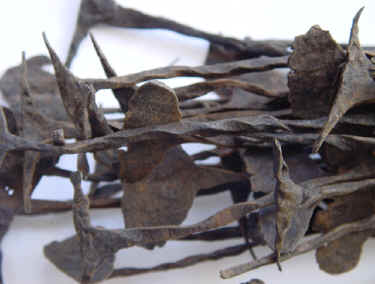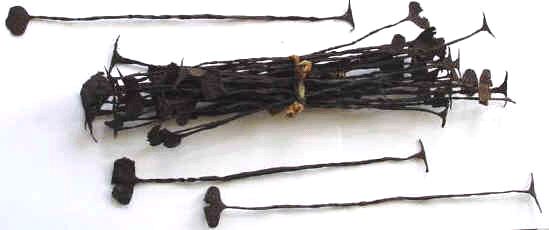|
Kissi Money or ‘Money with a Soul’
At the end of the 19th century, the so-called ‘Kissi money’ or ‘Kissi penny’ was introduced by the Kissi, Loma and Bandi peoples living in the border regions of nowadays Liberia, Sierra Leone and Guinea.
 In practice its use was quite extensive. Various sources mention the use of the Kissi money among and between the Bandi, Gbandia, Gola, Kissi, Kpelle, Loma, Mandingo and Mende tribes of this region. Presumably, Kissi money was ‘minted’ as from the 1880s by native blacksmiths who used iron smelted from the rich ore in the region. For many decades Kissi money circulated along with American, British and French paper money. In practice its use was quite extensive. Various sources mention the use of the Kissi money among and between the Bandi, Gbandia, Gola, Kissi, Kpelle, Loma, Mandingo and Mende tribes of this region. Presumably, Kissi money was ‘minted’ as from the 1880s by native blacksmiths who used iron smelted from the rich ore in the region. For many decades Kissi money circulated along with American, British and French paper money.
The shape of the Kissi money is rather odd. Its characteristic form is a twisted rod of iron with flattened ends: a flat, hoe-like spatula at one end and a sharpened ‘T’ at the other. Its length varies from 9 to over 15 inches, the longer ones representing a higher value. Larger ‘denominations’ also were created by twisting several pieces together or bundling them and securing them with a cotton or leather strip. The odd shape may have its origin as a means of protection since it was virtually impossible to tamper with the metal content of the piece without noticing it immediately.
If an iron rod would accidentally break, it could no longer circulate and its value could only be restored in a special ceremony performed by the Zoe, the traditional witchdoctor – often the blacksmith – who, for a fee, would rejoin the broken pieces and reincarnate the escaped soul. Therefore, it was said that Kissi money was ‘money with a soul’.
The Kissi money was a general-purpose currency. Kissi pennies were tied in bundles of twenty and used for a variety of purposes. In the beginning of the 20th century a cow would cost 100 bundles, a virgin bride 200 bundles and a slave 300 bundles.
The French were the first to abolish the use of the Kissi money in their colony. The British followed in 1940. In Liberia things went much slower. In 1936 the District Commissioner at Voinjama, the most northern District of Liberia’s Western Province bordering the French colony of Guinea and the British colony of Sierra Leone, attempted to prohibit the use of Kissi money in payment of the much despised hut tax. Eight years earlier the U.S. Firestone Company had come to Liberia but the company’s operations were concentrated in regions located more to the coast. Since the North American rubber company hardly affected their way of life, the tribal people in the northwestern part of the country continued using the traditional money. It was only after the administrative reform of 1964 and the emergence of modern employers in the 1960s (plantations, iron ore mines), due to President Tubman’s Open Door Policy, that the Kissi money was definitely replaced by the official currency of Liberia - since 1944 the US dollar. In that year President Edwin Barclay had outlawed the British pound and
made the US dollar the only legal tender in the
country.
After being replaced by Western currencies, the use of Kissi money became virtually limited to ritual ceremonies such as on the occasion of the return of young men and women from the bush schools (Poro and Sande schools) or for sacrifices and divination ceremonies. It also serves for making protective fetishes and to decorate the graves of old warriors. Still many people believe the old money to possess magical powers. Hence, according to many tribal Liberians, the Kissi money still is ‘money with a soul’.
home

|

 In practice its use was quite extensive. Various sources mention the use of the Kissi money among and between the Bandi, Gbandia, Gola, Kissi, Kpelle, Loma, Mandingo and Mende tribes of this region. Presumably, Kissi money was ‘minted’ as from the 1880s by native blacksmiths who used iron smelted from the rich ore in the region. For many decades Kissi money circulated along with American, British and French paper money.
In practice its use was quite extensive. Various sources mention the use of the Kissi money among and between the Bandi, Gbandia, Gola, Kissi, Kpelle, Loma, Mandingo and Mende tribes of this region. Presumably, Kissi money was ‘minted’ as from the 1880s by native blacksmiths who used iron smelted from the rich ore in the region. For many decades Kissi money circulated along with American, British and French paper money.